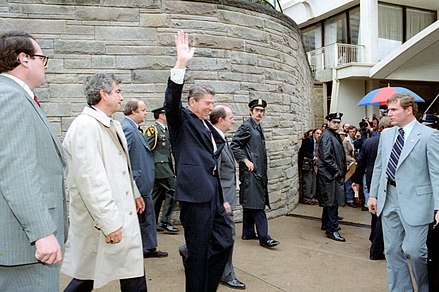The Brady Handgun Violence Prevention Act, enacted November 30, 1993, often referred to as the Brady Act, the Brady Bill or the Brady Handgun Bill, is an Act of the United States Congress that mandated federal background checks on firearm purchasers in the United States. It also imposed a five-day waiting period on purchases until the National Instant Criminal Background Check System (NICS) was implemented in 1998. Introduced by U.S. Representative Chuck Schumer of New York, the Brady Act was a landmark legislative enactment during the Clinton administration. The act was appended to the end of Section 922 of title 18, United States Code. The intention of the act was to prevent persons with previous serious convictions from purchasing firearms.
The bill came about during the assassination attempt on President Ronald Reagan in 1981. James Brady was press secretary to President Ronald Reagan when both he and the president, along with Secret Service agent Tim McCarthy and District of Columbia police officer Thomas Delehanty, were shot on March 30, 1981, during an assassination attempt by John Hinckley Jr. Brady was shot in the head and suffered a serious wound that left him partially paralyzed for life.
John Hinckley Jr. bought the .22 caliber Röhm RG-14 revolver used in the shooting at a Dallas, Texas, pawn shop on October 13, 1980. In a purchase application that he filled out before taking possession of the revolver, he provided a false home address on the form and showed an old Texas driver’s license as “proof” that he lived there. This constituted a felony offense. Additionally, Hinckley had been arrested four days earlier at the Metropolitan Airport in Nashville, Tennessee, when he attempted to board an American Airlines flight for New York with three handguns and some loose ammunition in his carry-on bag. That same day, President Jimmy Carter was in Nashville and scheduled to travel to New York. Finally, Hinckley had been under psychiatric care prior to his gun purchase.
According to Brady’s wife, Sarah, had a background check been conducted on Hinckley, it could have detected some, or all, of this important criminal and mental health history. Sarah became active in the gun control movement a few years after the shooting. She joined the Board of Handgun Control, Inc. (HCI) in 1985 and became its chair in 1989. Two years later, she became Chair of the center to Prevent Handgun Violence, HCI’s 501(c)(3) sister organization. In 2001, the organizations were renamed the Brady Campaign to Prevent Gun Violence and the Brady Center to Prevent Gun Violence in honor of James and Sarah.
However, in 2000, controversy arose when Sarah Brady purchased a .30-06 Springfield rifle in Delaware for her son. Gun rights groups claimed that this action was a straw purchase, intended to avoid the NICS, and may have also violated Delaware firearms purchase laws. No charges were ever filed against Sarah Brady, however. A firearm purchased as a gift is not considered a straw purchase under U.S. federal law if the recipient may legally possess it. Critics pointed out, however, that private firearm transfers like the one made by Sarah Brady are a common concern of gun control advocates (although exemptions for family members have been allowed in past legislation to regulate such sales).
After the Brady Act was originally proposed in 1987, the National Rifle Association (NRA) mobilized to defeat the legislation, spending millions of dollars in the process. While the bill eventually did pass in both chambers of the United States Congress, the NRA was able to win an important concession: the final version of the legislation provided that, in 1998, the five-day waiting period for handgun sales would be replaced by an instant computerized background check that involved no waiting periods.
The NRA then funded lawsuits in Arizona, Louisiana, Mississippi, Montana, New Mexico, North Carolina, Texas, Vermont and Wyoming that sought to strike down the Brady Act as unconstitutional. These cases wound their way through the courts, eventually leading the U.S. Supreme Court to review the Brady Act in the case of Printz v. United States.
In Printz, the NRA argued that the Brady Act was unconstitutional because its provisions requiring local law enforcement officers to conduct background checks was a violation of the 10th Amendment to the Constitution (Brief Amicus Curiae of the National Rifle Association of America in Support of Petitioners, Printz v. United States, 521 U.S. 898, 1997). Based on these grounds, the NRA told the Court “the whole Statute must be voided.”
In its 1997 decision in the case, the Supreme Court ruled that the provision of the Brady Act that compelled state and local law enforcement officials to perform the background checks was unconstitutional on 10th amendment grounds. The Court determined that this provision violated both the concept of federalism and that of the unitary executive. However, the overall Brady statute was upheld and state and local law enforcement officials remained free to conduct background checks if they so chose. The vast majority continued to do so. In 1998, background checks for firearm purchases became mostly a federally run activity when NICS came online, although many states continue to mandate state run background checks before a gun dealer may transfer a firearm to a buyer.[citation needed]
Background checks for firearms purchases operate in only one direction because of the Firearm Owners Protection Act. That is, although a firearms dealer may obtain electronic information that an individual is excluded from firearms purchases, the FBI and the Bureau of Alcohol, Tobacco, Firearms, and Explosives (ATF) do not receive electronic information in return to indicate what firearms are being purchased.

